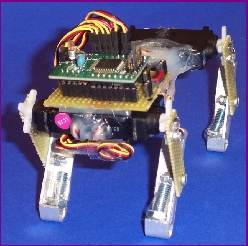Diplomarbeit
MiniDog6M
Das Hauptziel dieses relativ neuen Forschungsgebietes ist es, die grundlegenden Prinzipien von intelligentem Verhalten herauszuarbeiten und zu vestehen.
Diese Prinzipien ermöglichen uns, die natürlichen Formen von Intelligenz (Menschen und Tiere) zu verstehen und dadurch intelligente Systeme (Roboter) zu konstruieren.
Diese Vorgehensweise wird gerne durch "understanding by building" charakterisiert. Dabei werden zuerst Teile eines biologischen Systems nachgebaut,
aus den Erfahrungen mit diesem System werden dann grundlegende Prinzipien abstrahiert und zum Design gelungener Artefakte ausgenutzt.
Die zugrundeliegenden Forschungsgebiete sind: Biorobotik, Lernen, experimentelle Robotik, Morphogenese, Evolution,
Selbstorganisation, neuronale Netze und kollektive Intelligenz.
Die wichtigsten Ansätze sind:
- Verkörperung: Um intelligentes Verhalten zu ergründen genügt kein bloßes Computerprogramm, sondern es benötigt auch einen physikalischen Körper, um mit seiner
Umgebung zu interagieren
- Morphologie: Dabei sind besonders die Materialien, die Form und die Art und Anordnung der Aktuatoren und Sensoren wichtig
- Kopplung von System und Umgebung und die körpereigene Dynamik: Diese können einen Teil der aktiven Kontrolle ersetzen durch die Interaktion
mit der Umwelt und somit der Begünstigung der Emergenz von neuen Verhalten
- Verhaltensdiversität: Das Beherrschen möglichst vieler verschiedener Verhalten ist Teil jeder heutigen Definition von Intelligenz
- Billige Konstruktionen: Hier nicht im Sinne von Robotern für wenig Geld, sondern von sparsamer Sensorik, Motorik und Kontrolle und trotzdem einem reichhaltigem
Verhaltensrepertoire
- Ökologischer Balance: Vergleichbare Komplexität von physikalischem Aufbau, Aufgabe und Kontrolle
In diesem Zusammenhang entwickelte ich eine Methode und die dazu gehörigen Bewertungsmasse zur Untersuchung der Auswirkungen von Motorprimitiven und
physikalischer Struktur auf die Steuerung eines Roboters. Die Fallstudie dabei war das Aufstehen eines Roboterhundes.
Abstract:
"One of mankind’s prevalent interests is to understand the principles of nature, above all the enormous abilities of learning, adaptation and the wide
spectrum of design principles of musculo-skeletal systems. Apparently, the solution cannot be found in just one component, but is distributed over the whole
system and arises from their dynamic interplay. In many cases, humans and animals gain higher behaviours by combining well known lower level components
instead of learning from scratch. Additionally, we can find evidence that even some animals entire locomotion repertoire is designed according to this very
principle, namely as sequential or linear combination of low level motor primitives. Recent advances also take for granted that all movements are intended
as cyclic motion. Needless to say that the use of oscillations makes linear combination straightforward. The interesting issue considering artificial
agents is how to generate a good basis of motor primitives. Moreover, we hope that this approach will offer us a little more insight into animal and human
behaviour. In this context, we present the first in a series of experiments that serve the development of a quality criterion for the design and analysis of
meaningful motor primitives. The first step towards such guidelines elaborates the impact of different vocabularies on behavioural diversity, robustness of
pre-learned behaviours and learning process. The case study is a locomotion task of running and having the robot stand up from a lying position. To
investigate these ideas, the quadruped robot MiniDog6M is controlled by a simple sinusoidal function for each of its motors. Further, we apply reinforcement
learning to train a linear approximator estimating a Q-Function for a variety of motor primitives, each consisting of a set of frequencies."
Keywords: Motor primitive, morphology, behavioural diversity, linear approximator, reinforcement learning, sinusoidal control
Ein kurze Zusammenfassung der wichtigsten Punkte findet ihr
hier.
Die gesamte Ausarbeitung bekommt ihr
hier.
Das erste
Paper erschien bei der diesjährigen Clawar-Konferenz (Kletter- und Laufroboter) .
Videos:
Links:
Näheres zum Rahmenprojekt, das sich um ein minimalistisches und dennoch biologisch plausibles Design für schnelles Rennen bemüht:
Running Dog Project
Sehr Empfehlenswert als Einstieg in die sogenannte Embodied AI ist das Buch
"Understanding Intelligence" von Rolf Pfeifer und Christian Scheier, MIT Press 1999.
|
